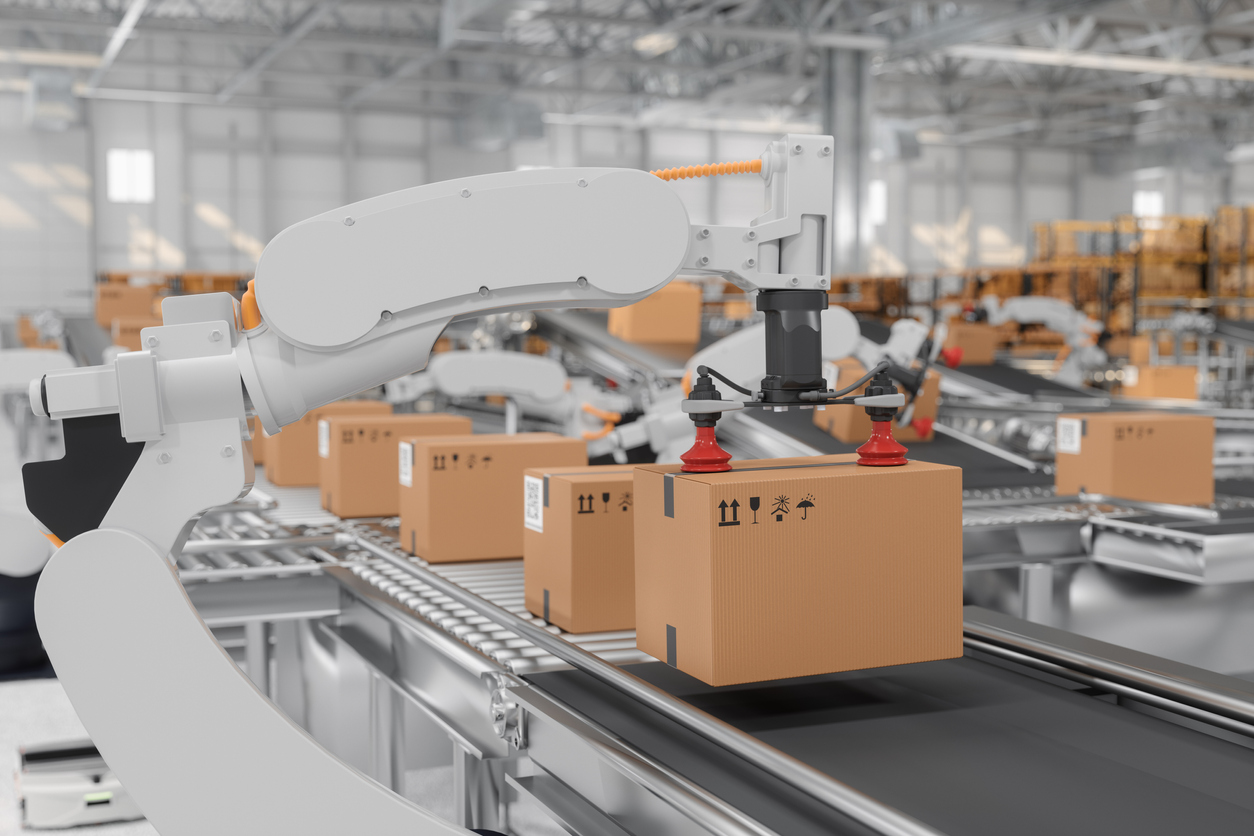AI-Driven Warehouse Optimization: Streamlining Operations with Advanced Technology
Although monetary experts may disagree on the world’s economic future, most concede that inflation will significantly impact business growth. Borrowing becomes more expensive as interest rates increase. Reducing expenditures becomes a priority to preserve cash reserves. For organizations, an uncertain economy means finding ways to improve operational efficiencies and increase productivity.
Many companies are looking to improve their supply chains as costs for shipping, storing, and delivering goods continue to rise. A recent survey found energy costs, labor shortages, and supply chain limitations to be three challenges for reducing logistics costs. Electricity rates have increased by 12% per year. Retail rates have increased by 60% since 2000. That doesn’t include fuel costs for transporting goods.
Logistics labor shortages from truck drivers to warehouse employees continue to impact supply chain efficiencies. A Deloitte study found that logistics leaders consider retaining and finding talent as their top challenges. With fewer employees, warehouse staff can become overwhelmed trying to meet demand. Gradually, operational efficiencies decline, and operations become more error-prone.
Volatility remains a crucial factor in supply chain disruptions. Ports are still congested. Long lead times are common. Warehouses are full. The landscape lacks the flexibility needed to address ever-changing logistics. Geopolitical events and natural disasters add uncertainty to the supply chain. Predicting the future seems impossible.
How Can AI Technology Help?
Many industry leaders are looking to technology to address these challenges. When surveyed, shippers and third-party logistics (3PL) companies said that technology was a differentiator when evaluating partnerships. With technology, 3PL providers can automate processes to reduce labor demands. They can use artificial intelligence (AI) to optimize routes for maximum fuel efficiency and monitor warehouses for energy use. Companies can use data analytics for better forecasting and improved processes.
With AI-driven warehouse optimization technology, the logistics industry can streamline operations to reduce expenses and preserve cash reserves to navigate the volatile economic landscape. The industry can minimize the impact of supply chain disruptions with more resilient processes. Let’s take a closer look at how AI technology can help streamline warehouse operations.
Address Labor Shortages through Automation
A 2022 report found that 57% of warehouse executives see labor shortages as a hindrance to meeting demand, with 47% planning to invest in automation to counter poor employee retention. For example, robotic process automation (RPA) allows companies to automate business processes through software that emulates human actions. RPA can reduce human participation in order entry tasks through automated order processing.
AI-Based Robotic Process Automation
With an RPA process, the software reviews the order to ensure the required information is present and determines if the items are in stock. If an item is unavailable, the software forwards the order to an employee for handling. With an AI-infused RPA solution, the process doesn’t stop when an out-of-stock item is discovered. Advanced technologies in warehouse management can move operations to the next level.
Instead of forwarding the order to an employee, AI identifies possible substitutions and forwards an email to the customer indicating the item is back-ordered and recommends possible alternatives. Based on the customer response, AI can remove the item or replace it with a suggested option. With the addition of AI, employees are not spending time resolving orders and re-issuing paperwork. They are moving on to more high-value tasks.
Warehouse Automation
Moving inventory is a labor-intensive component of warehouse operations. Depending on warehouse size, employees traverse miles in a single day, often backtracking to fulfill an order. Incorporating robots into operations can reduce labor demands and improve warehouse safety. Warehouse robotics can also reduce order fulfillment errors.
- Automated Guided Vehicles (AGVs). AGVs require specialized warehouses that enable robot-operated forklifts and pick carts to move inventory. Not only do they move inventory faster, but they also improve worker safety.
- Autonomous Mobile Robots (AMRs). AMRs are more versatile than AGVs. They do not require specialized tracking systems to navigate. By adding intelligence, AMRs can map an entire warehouse and use sensors to avoid obstacles. They can update their databases to maintain a current map of a facility.
- Automated Storage and Retrieval Systems (AS/RS). ASR systems like AGVs require tracking to manage warehouse storage. Warehouses often use AS/RS to maximize space as they can operate in narrow aisles and can access goods stored at higher levels.
Other automated solutions work with warehouse employees to streamline operations for faster order fulfillment.
Optimize Warehouse Operations with AI
RPA solutions that incorporate AI enable warehouse managers to deploy systems that can deliver decision-making capabilities. Whether order processing or invoice tracking, AI learns from experience, allowing for ongoing improvements that optimize operations.
Semi-Autonomous Robots
Using semi-autonomous robots combines the strengths of technology with human capabilities. For example, robots can assist employees with picking tasks. Employees can use mobile robots to hold items as they collect items for orders. The robots can hold more items and can quickly deliver them to a central location before returning to carry more items. The solution is less expensive than fully automated solutions but still delivers efficiencies by reducing the time employees spend picking orders.
Warehouse Design
AI tools can help optimize warehouse storage capabilities. Inventory moves in and out of warehouses continuously. Making sure that each square inch is utilized requires far more attention to detail than most employees have time to consider. AI was designed for details.
With a warehouse map and data on inventory movement, AI solutions can move inventory to place fast-moving items in close proximity. Fewer steps mean faster order fulfillment. These minor adjustments would be cost-prohibitive without AI.
Inventory Management
Adding AI to inventory management provides a more comprehensive view of what happens during order fulfillment. AI analyzes hundreds of thousands of data points, searching for patterns that can improve operations. AI-powered inventory management solutions can monitor stocking levels to ensure items are always available. The solution can contact the shipper automatically, eliminating employee involvement.
AI’s predictive abilities not only help with inventory management and warehouse optimization but also help minimize the impact of supply chain disruptions.
Minimize Supply Chain Disruptions
Understanding how supply chain disruptions impact warehouse efficiencies means identifying patterns that tie internal and external events. For example, AI-driven warehouse optimization detects a slowing of deliveries to the warehouse from a specific merchant. Although the delays have not created stockouts, AI technology predicts a shortage if the pattern continues.
Predictive Capabilities
Using external data, AI isolates the increase in delivery times to a three-month period. The warehouse manager proactively contacts the supplier to discuss the delays. During that three-month period, employees take vacations, which slows manufacturing as temporary staff is hard to find.
After the discussion, the manager queries the AI solution to determine the increase in inventory that would be required to maintain consistent levels during the slow period. AI’s predictive capabilities enable 3PL providers to help their customers avoid stockouts and ensure warehouse efficiencies.
Demand Planning
Knowing changes in demand enables 3PL companies and their customers to ensure stock is available for Black Friday or Cyber Monday. Rather than increase shipments throughout the year and pay for added storage, companies can use AI to calculate how much to increase shipments for specific events to avoid supply chain disruptions.
Optimizing space utilization improves operating efficiencies. Space is not used to store slow-moving products, and staff are not required to navigate around them to find the faster-selling items. Less time needed to fulfill an order means a faster delivery window for the buyer.
Risk Management
AI plays a strategic role in managing supply chain disruption because of cyber attacks. Although the SolarWinds attack in 2020 brought attention to the impact a cyber attack could have on a supply chain, many organizations do not see it as an ongoing threat. However, the last six months saw five major attacks that created supply chain disruptions.
Logistics providers are an essential component in any supply chain. They communicate in real time with customers and carriers. Gaining access to a warehouse operator could let hackers infiltrate all points in the supply chain. Once compromised, operations would be disrupted until the attack was contained.
AI can monitor real-time interactions and identify anomalies that may indicate a possible attempt. Early notification enables companies to thwart the attack before a disruption occurs. For example, AI may detect an unusual number of requests from a warehouse customer and alert staff to possible infiltration attempts. AI can even terminate the connection until the event is investigated.
Overcoming Challenges to Warehouse Operations with AI
AI technology can help warehouse operators overcome challenges created by a volatile economic landscape. Through warehouse optimization, companies can create operational efficiencies that reduce costs and preserve capital resources. 3PL providers can automate warehouse operations to compensate for labor shortages while increasing productivity.
With AI-based solutions, organizations can gain insights into operations through predictive analytics and inventory management. Knowing when to add products to avoid stockouts prevents disruptions that can increase costs. Last-minute or rush reorders can eat into anyone’s profit.
As every business struggles in today’s economic environment, consider a 3PL provider with AI technology to help address warehousing challenges. Contact us to discuss how we can help.







